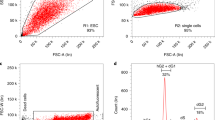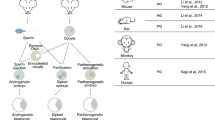Summay
A new established cell line 79f7Dv3g, ofDrosophila virilis consisting initially of male and female cells and represented now, after 6 yr of cultivation, only by male cells is described. The population doubling time is 36 h at 25° C. The cell culture is also able to grow in serum-free media for an indefinite time without special selection and has a population doubling time of 2 d.
Similar content being viewed by others
References
Chen, T. R. In situ detection of Mycoplasma contamination in cell culture by fluorescent Hoechst 33258 stain. Exp. Cell Res. 104:255–262; 1977.
Evgenyev, M. B.; Enikolopov, G. N.; Peunova, N. I., et al. Transposition of mobile genetic elements in interspecific hybrids of Drosophila. Chromosoma 85:375–386; 1982.
Epifanova, O. I.; Terskikh, V. V.; Zakharov, A. F. Radioautography. Moscow: Vysshaya shkola; 1977:151–157.
Gvozdev, V. A.; Kakpakov, V. T. Culture of embryonic cells ofDrosophila melanogaster in vitro. Genetika (USSR) 4:129–142; 1968. Translation of Genetika (Moscow) 4:142; 1968.
Ilyin, Yu. V.; Chmeliauskaite, V. G.; Ananiev, E. V., et al. Multiple dispersedDrosophila melanogaster genes with varying location. VI. Structural organization of the mobile dispersed genes 1 and 3. Genetika (USSR) 17:199–210; 1981. Translation of Genetika (Moscow) 17:210; 1981.
Kakpakov, V. T.; Gvozdev, V. A.; Platova, T. P., et al.. In vitro establishment of embryonic cell linesDrosophila melanogaster genetika (USSR) 5:67–75; 1969. Translation of Genetika (Moscow) 5:75; 1969.
Kakpakov, V. T.; Schuppe, N. G. Insect cell culture nutrient medium KS-10 Author's certificate SU 1181312A; C12N5]00, May 22, 1985.
Moorhead, P. S.; Nowell, P. C.; Mellman, W. J., et al. Chromosome preparations of leukocytes cultured from human peripheral blood. Exp. Cell Res. 20:613–616; 1960.
Potter, S. S.; Brorein W. J. Jr.; Dunsmuir, P., et al. Transposition of elements of the 412, copia and 297 dispersed repeated gene families in Drosophila. Cell 17:415–427; 1979.
Sang, J. H. Drosophila cells and cell lines. In: Maramorosch, K., ed. Advances in cell culture, vol. 1. New York: Academic Press; 1981:125–182.
Schneider, I.; Blumenthal, A. B. Drosophila cell and tissue culture. In: Ashburner, M.; Wright, T. R. F., eds. The genetics and biology of Drosophila, vol. 2A. New York: Academic Press; 1978:206–315.
Shields, G.; Sang, J. H. Improved medium for culture of Drosophila embryonic cells. DIS 52:161; 1977.
Zelentsova, E. T.; Braude-Zolotarjova, T.; Evgenyev, M. B. Supernumerous family of mobile dispersed genetic elements isolated fromD. virilis genome lacks the ability to amplify. Drosophila Information Service 59:138; 1983.
Author information
Authors and Affiliations
Rights and permissions
About this article
Cite this article
Braude-Zolotarjova, T.Y., Kakpakov, V.T. & Schuppe, N.G. Male diploid embryonic cell line ofDrosophila virilis . In Vitro Cell Dev Biol 22, 481–484 (1986). https://doi.org/10.1007/BF02623449
Received:
Accepted:
Issue Date:
DOI: https://doi.org/10.1007/BF02623449




